jump start CHEVROLET SUBURBAN 2003 9.G Owners Manual
[x] Cancel search | Manufacturer: CHEVROLET, Model Year: 2003, Model line: SUBURBAN, Model: CHEVROLET SUBURBAN 2003 9.GPages: 552, PDF Size: 3.44 MB
Page 377 of 552
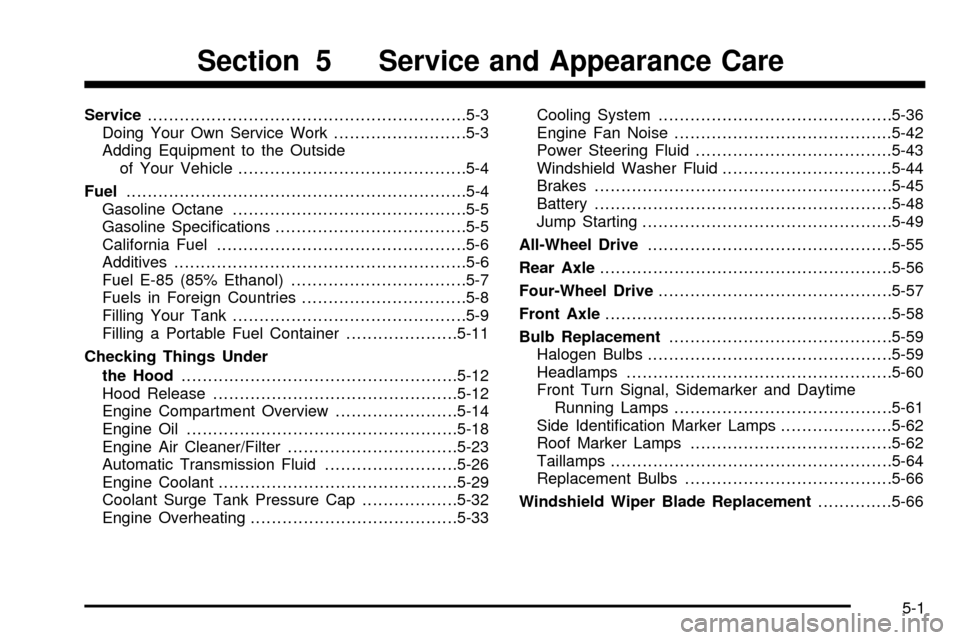
Service............................................................5-3
Doing Your Own Service Work.........................5-3
Adding Equipment to the Outside
of Your Vehicle...........................................5-4
Fuel................................................................5-4
Gasoline Octane............................................5-5
Gasoline Speci®cations....................................5-5
California Fuel...............................................5-6
Additives.......................................................5-6
Fuel E-85 (85% Ethanol).................................5-7
Fuels in Foreign Countries...............................5-8
Filling Your Tank............................................5-9
Filling a Portable Fuel Container.....................5-11
Checking Things Under
the Hood....................................................5-12
Hood Release..............................................5-12
Engine Compartment Overview.......................5-14
Engine Oil...................................................5-18
Engine Air Cleaner/Filter................................5-23
Automatic Transmission Fluid.........................5-26
Engine Coolant.............................................5-29
Coolant Surge Tank Pressure Cap..................5-32
Engine Overheating.......................................5-33Cooling System............................................5-36
Engine Fan Noise.........................................5-42
Power Steering Fluid.....................................5-43
Windshield Washer Fluid................................5-44
Brakes........................................................5-45
Battery........................................................5-48
Jump Starting...............................................5-49
All-Wheel Drive..............................................5-55
Rear Axle.......................................................5-56
Four-Wheel Drive............................................5-57
Front Axle......................................................5-58
Bulb Replacement..........................................5-59
Halogen Bulbs..............................................5-59
Headlamps..................................................5-60
Front Turn Signal, Sidemarker and Daytime
Running Lamps.........................................5-61
Side Identi®cation Marker Lamps.....................5-62
Roof Marker Lamps......................................5-62
Taillamps.....................................................5-64
Replacement Bulbs.......................................5-66
Windshield Wiper Blade Replacement..............5-66
Section 5 Service and Appearance Care
5-1
Page 391 of 552
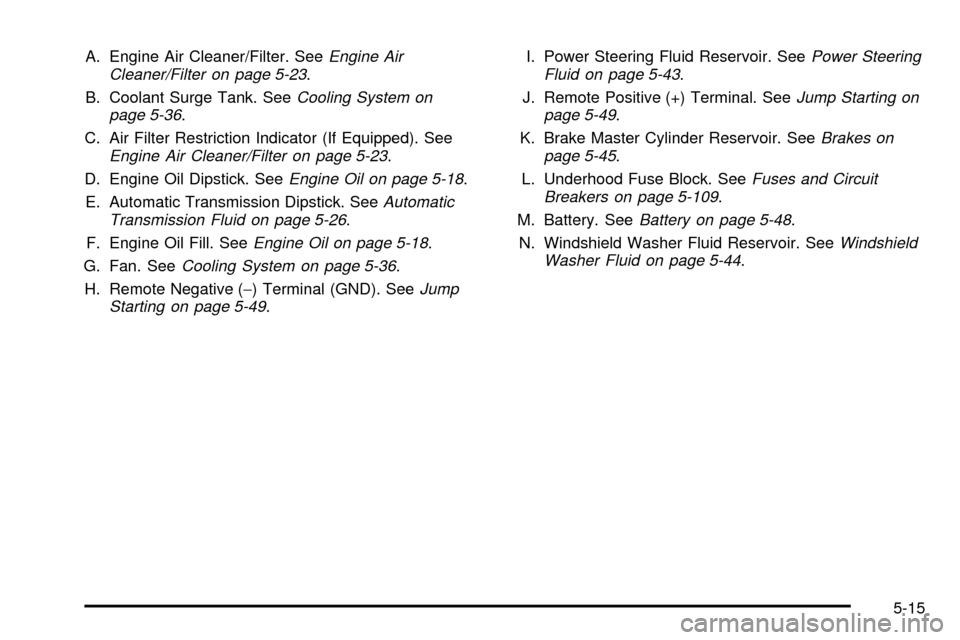
A. Engine Air Cleaner/Filter. SeeEngine Air
Cleaner/Filter on page 5-23.
B. Coolant Surge Tank. See
Cooling System on
page 5-36.
C. Air Filter Restriction Indicator (If Equipped). See
Engine Air Cleaner/Filter on page 5-23.
D. Engine Oil Dipstick. See
Engine Oil on page 5-18.
E. Automatic Transmission Dipstick. See
Automatic
Transmission Fluid on page 5-26.
F. Engine Oil Fill. See
Engine Oil on page 5-18.
G. Fan. See
Cooling System on page 5-36.
H. Remote Negative (-) Terminal (GND). See
Jump
Starting on page 5-49.I. Power Steering Fluid Reservoir. See
Power Steering
Fluid on page 5-43.
J. Remote Positive (+) Terminal. See
Jump Starting on
page 5-49.
K. Brake Master Cylinder Reservoir. See
Brakes on
page 5-45.
L. Underhood Fuse Block. See
Fuses and Circuit
Breakers on page 5-109.
M. Battery. See
Battery on page 5-48.
N. Windshield Washer Fluid Reservoir. See
Windshield
Washer Fluid on page 5-44.
5-15
Page 393 of 552
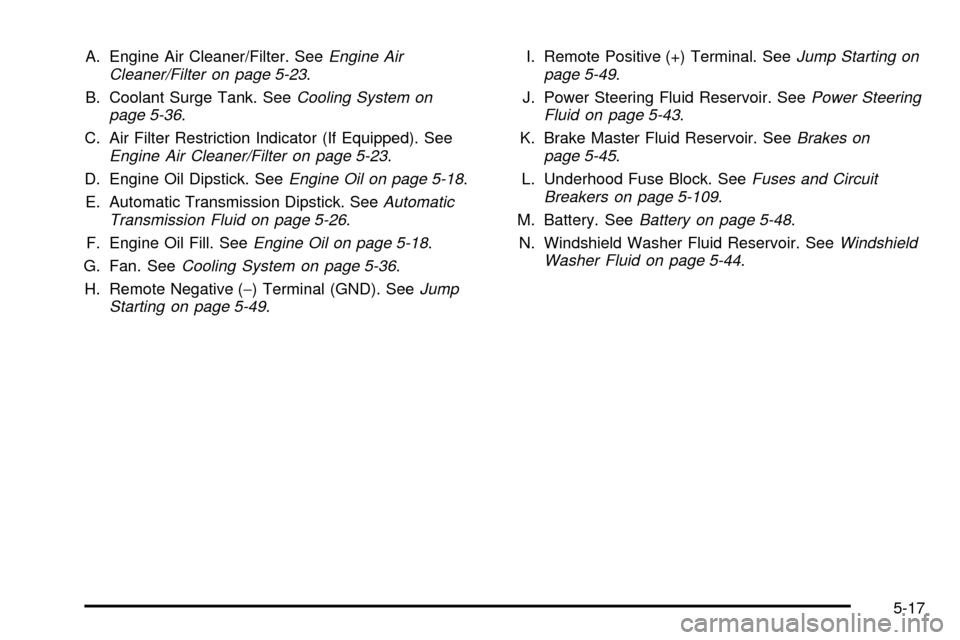
A. Engine Air Cleaner/Filter. SeeEngine Air
Cleaner/Filter on page 5-23.
B. Coolant Surge Tank. See
Cooling System on
page 5-36.
C. Air Filter Restriction Indicator (If Equipped). See
Engine Air Cleaner/Filter on page 5-23.
D. Engine Oil Dipstick. See
Engine Oil on page 5-18.
E. Automatic Transmission Dipstick. See
Automatic
Transmission Fluid on page 5-26.
F. Engine Oil Fill. See
Engine Oil on page 5-18.
G. Fan. See
Cooling System on page 5-36.
H. Remote Negative (-) Terminal (GND). See
Jump
Starting on page 5-49.I. Remote Positive (+) Terminal. See
Jump Starting on
page 5-49.
J. Power Steering Fluid Reservoir. See
Power Steering
Fluid on page 5-43.
K. Brake Master Fluid Reservoir. See
Brakes on
page 5-45.
L. Underhood Fuse Block. See
Fuses and Circuit
Breakers on page 5-109.
M. Battery. See
Battery on page 5-48.
N. Windshield Washer Fluid Reservoir. See
Windshield
Washer Fluid on page 5-44.
5-17
Page 425 of 552
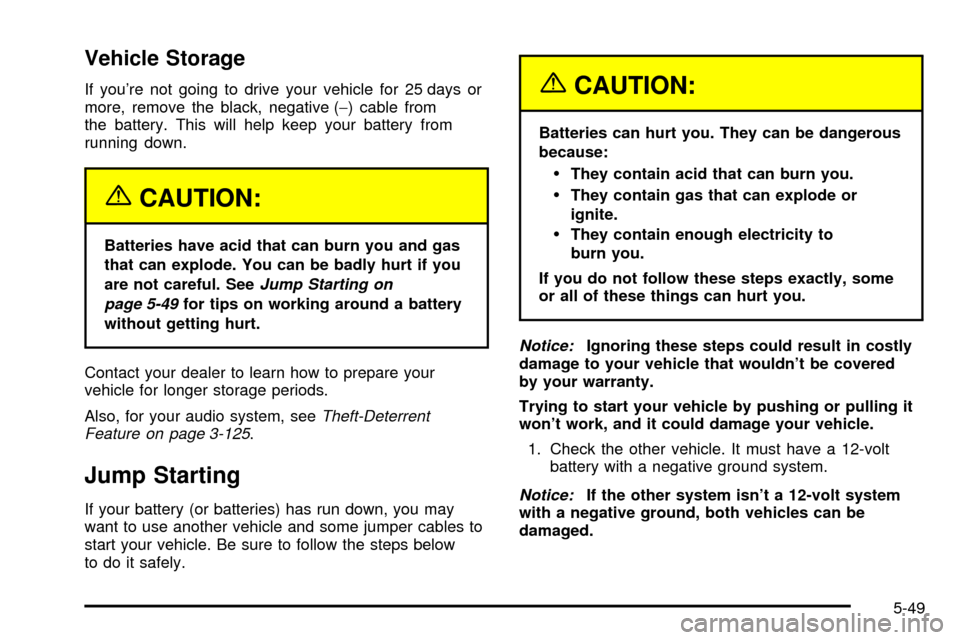
Vehicle Storage
If you're not going to drive your vehicle for 25 days or
more, remove the black, negative (-) cable from
the battery. This will help keep your battery from
running down.
{CAUTION:
Batteries have acid that can burn you and gas
that can explode. You can be badly hurt if you
are not careful. See
Jump Starting on
page 5-49
for tips on working around a battery
without getting hurt.
Contact your dealer to learn how to prepare your
vehicle for longer storage periods.
Also, for your audio system, see
Theft-Deterrent
Feature on page 3-125.
Jump Starting
If your battery (or batteries) has run down, you may
want to use another vehicle and some jumper cables to
start your vehicle. Be sure to follow the steps below
to do it safely.
{CAUTION:
Batteries can hurt you. They can be dangerous
because:
·They contain acid that can burn you.
·They contain gas that can explode or
ignite.
·They contain enough electricity to
burn you.
If you do not follow these steps exactly, some
or all of these things can hurt you.
Notice:Ignoring these steps could result in costly
damage to your vehicle that wouldn't be covered
by your warranty.
Trying to start your vehicle by pushing or pulling it
won't work, and it could damage your vehicle.
1. Check the other vehicle. It must have a 12-volt
battery with a negative ground system.
Notice:If the other system isn't a 12-volt system
with a negative ground, both vehicles can be
damaged.
5-49
Page 426 of 552
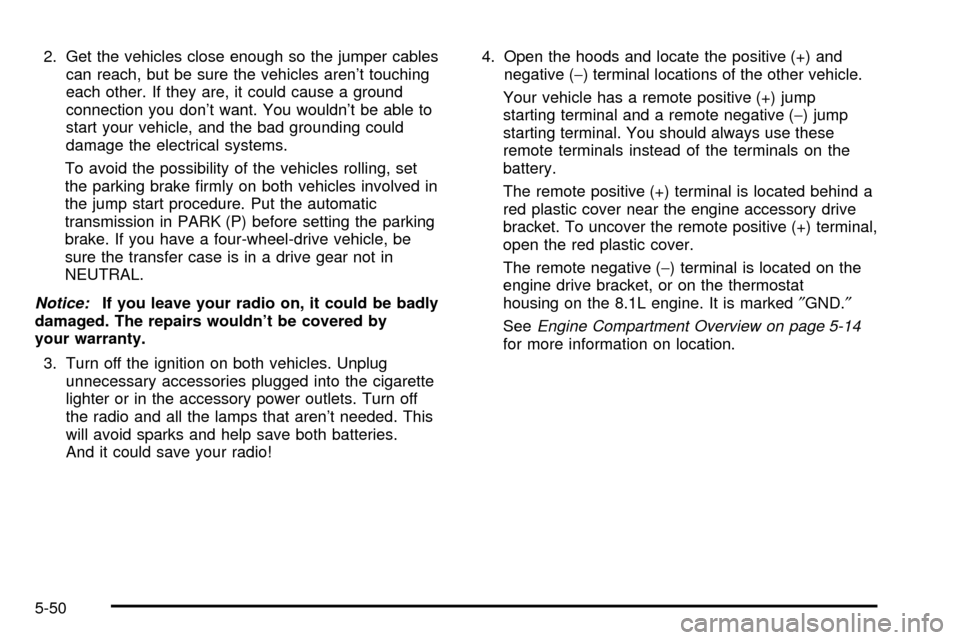
2. Get the vehicles close enough so the jumper cables
can reach, but be sure the vehicles aren't touching
each other. If they are, it could cause a ground
connection you don't want. You wouldn't be able to
start your vehicle, and the bad grounding could
damage the electrical systems.
To avoid the possibility of the vehicles rolling, set
the parking brake ®rmly on both vehicles involved in
the jump start procedure. Put the automatic
transmission in PARK (P) before setting the parking
brake. If you have a four-wheel-drive vehicle, be
sure the transfer case is in a drive gear not in
NEUTRAL.
Notice:If you leave your radio on, it could be badly
damaged. The repairs wouldn't be covered by
your warranty.
3. Turn off the ignition on both vehicles. Unplug
unnecessary accessories plugged into the cigarette
lighter or in the accessory power outlets. Turn off
the radio and all the lamps that aren't needed. This
will avoid sparks and help save both batteries.
And it could save your radio!4. Open the hoods and locate the positive (+) and
negative (-) terminal locations of the other vehicle.
Your vehicle has a remote positive (+) jump
starting terminal and a remote negative (-) jump
starting terminal. You should always use these
remote terminals instead of the terminals on the
battery.
The remote positive (+) terminal is located behind a
red plastic cover near the engine accessory drive
bracket. To uncover the remote positive (+) terminal,
open the red plastic cover.
The remote negative (-) terminal is located on the
engine drive bracket, or on the thermostat
housing on the 8.1L engine. It is marked²GND.²
See
Engine Compartment Overview on page 5-14for more information on location.
5-50
Page 429 of 552
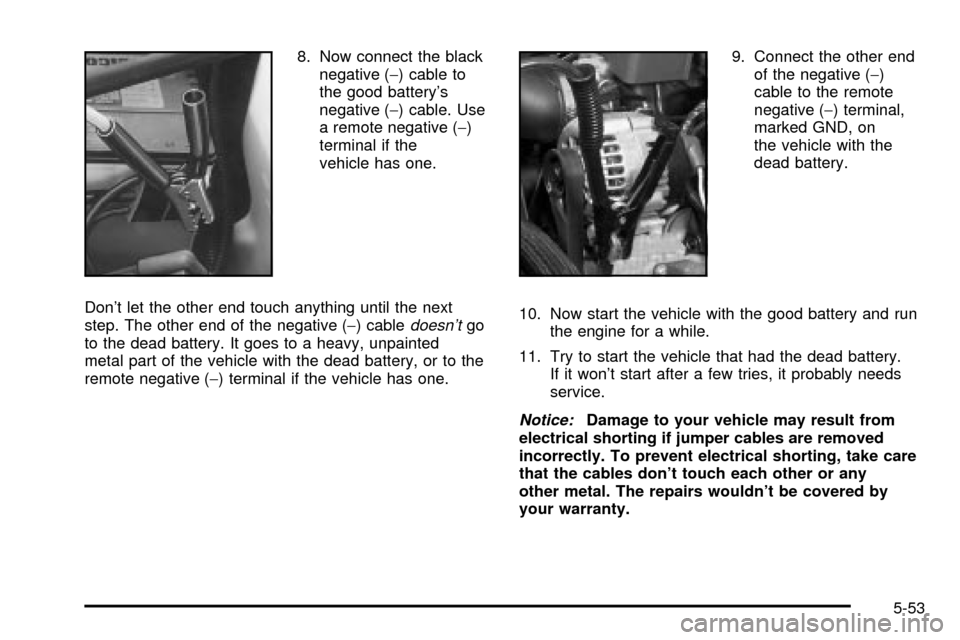
8. Now connect the black
negative (-) cable to
the good battery's
negative (-) cable. Use
a remote negative (-)
terminal if the
vehicle has one.
Don't let the other end touch anything until the next
step. The other end of the negative (-) cable
doesn'tgo
to the dead battery. It goes to a heavy, unpainted
metal part of the vehicle with the dead battery, or to the
remote negative (-) terminal if the vehicle has one.9. Connect the other end
of the negative (-)
cable to the remote
negative (-) terminal,
marked GND, on
the vehicle with the
dead battery.
10. Now start the vehicle with the good battery and run
the engine for a while.
11. Try to start the vehicle that had the dead battery.
If it won't start after a few tries, it probably needs
service.
Notice:Damage to your vehicle may result from
electrical shorting if jumper cables are removed
incorrectly. To prevent electrical shorting, take care
that the cables don't touch each other or any
other metal. The repairs wouldn't be covered by
your warranty.
5-53
Page 527 of 552
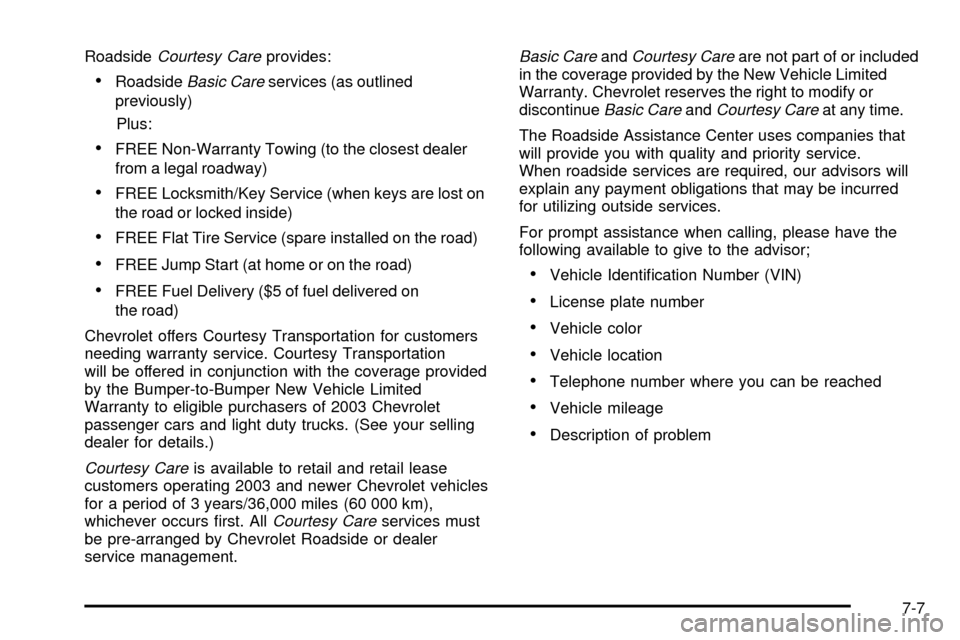
RoadsideCourtesy Careprovides:
·RoadsideBasic Careservices (as outlined
previously)
Plus:
·FREE Non-Warranty Towing (to the closest dealer
from a legal roadway)
·FREE Locksmith/Key Service (when keys are lost on
the road or locked inside)
·FREE Flat Tire Service (spare installed on the road)
·FREE Jump Start (at home or on the road)
·FREE Fuel Delivery ($5 of fuel delivered on
the road)
Chevrolet offers Courtesy Transportation for customers
needing warranty service. Courtesy Transportation
will be offered in conjunction with the coverage provided
by the Bumper-to-Bumper New Vehicle Limited
Warranty to eligible purchasers of 2003 Chevrolet
passenger cars and light duty trucks. (See your selling
dealer for details.)
Courtesy Careis available to retail and retail lease
customers operating 2003 and newer Chevrolet vehicles
for a period of 3 years/36,000 miles (60 000 km),
whichever occurs ®rst. All
Courtesy Careservices must
be pre-arranged by Chevrolet Roadside or dealer
service management.
Basic CareandCourtesy Careare not part of or included
in the coverage provided by the New Vehicle Limited
Warranty. Chevrolet reserves the right to modify or
discontinue
Basic CareandCourtesy Careat any time.
The Roadside Assistance Center uses companies that
will provide you with quality and priority service.
When roadside services are required, our advisors will
explain any payment obligations that may be incurred
for utilizing outside services.
For prompt assistance when calling, please have the
following available to give to the advisor;
·Vehicle Identi®cation Number (VIN)
·License plate number
·Vehicle color
·Vehicle location
·Telephone number where you can be reached
·Vehicle mileage
·Description of problem
7-7
Page 541 of 552
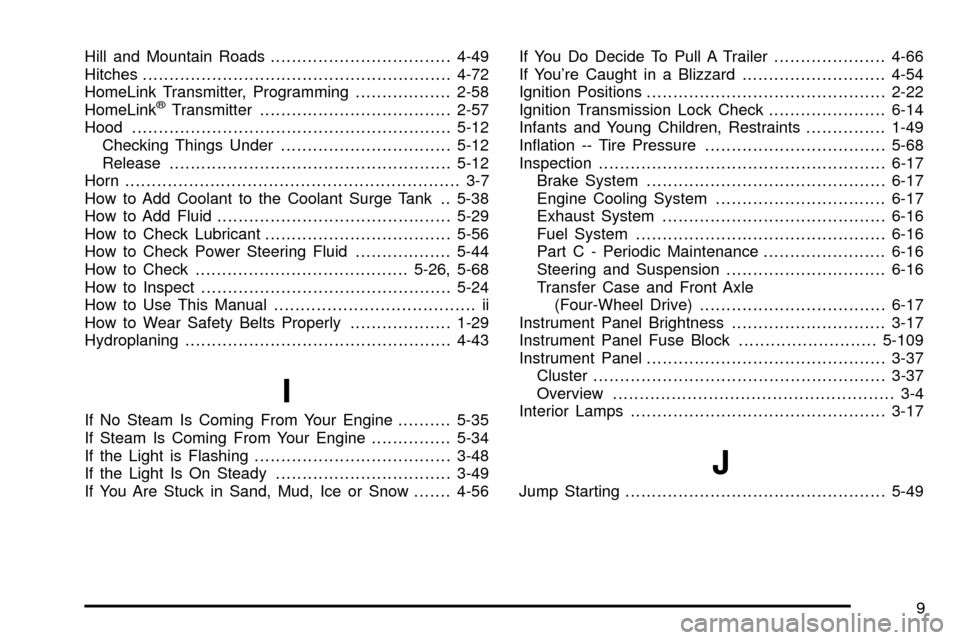
Hill and Mountain Roads..................................4-49
Hitches..........................................................4-72
HomeLink Transmitter, Programming..................2-58
HomeLink
žTransmitter....................................2-57
Hood............................................................5-12
Checking Things Under................................5-12
Release.....................................................5-12
Horn............................................................... 3-7
How to Add Coolant to the Coolant Surge Tank . . 5-38
How to Add Fluid............................................5-29
How to Check Lubricant...................................5-56
How to Check Power Steering Fluid..................5-44
How to Check........................................5-26, 5-68
How to Inspect...............................................5-24
How to Use This Manual...................................... ii
How to Wear Safety Belts Properly...................1-29
Hydroplaning..................................................4-43
I
If No Steam Is Coming From Your Engine..........5-35
If Steam Is Coming From Your Engine...............5-34
If the Light is Flashing.....................................3-48
If the Light Is On Steady.................................3-49
If You Are Stuck in Sand, Mud, Ice or Snow.......4-56If You Do Decide To Pull A Trailer.....................4-66
If You're Caught in a Blizzard...........................4-54
Ignition Positions.............................................2-22
Ignition Transmission Lock Check......................6-14
Infants and Young Children, Restraints...............1-49
In¯ation -- Tire Pressure..................................5-68
Inspection......................................................6-17
Brake System.............................................6-17
Engine Cooling System................................6-17
Exhaust System..........................................6-16
Fuel System...............................................6-16
Part C - Periodic Maintenance.......................6-16
Steering and Suspension..............................6-16
Transfer Case and Front Axle
(Four-Wheel Drive)...................................6-17
Instrument Panel Brightness.............................3-17
Instrument Panel Fuse Block..........................5-109
Instrument Panel.............................................3-37
Cluster.......................................................3-37
Overview..................................................... 3-4
Interior Lamps................................................3-17
J
Jump Starting.................................................5-49
9